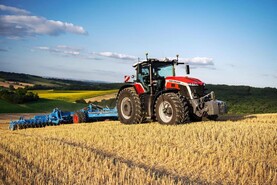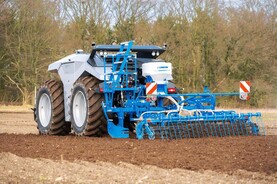Watermaster floating pump
Although not new to the market, this year marks 50 years of the Watermaster floating pump (above). Exhibited at Agritechnica, the Canadian-made lightweight (36kg) self-contained, self-priming, water pump has hundreds of uses including domestic, commercial and agricultural applications. For example, it can be used to pump out flooded slatted-tank excavations to emergency flood relief situations. The 5.5hp petrol engine is capable of pumping up to 191,000 litres per hour (42,000 gallons).
There is no inlet pipe as the numerous inlet holes are on the circumference of the machine just above the base. It can continue to work until it bottoms out in 100mm of water and can be fitted with a float valve to turn it off once it runs out of water. The advantage of this feature is it can be turned on and left to work autonomously. The pump instantly primes itself, doesn’t get air-locked and has an impressive pump ability to lift fluid over 9m without any significant drop in performance, which covers the majority of applications.
The large inlet and specially designed impeller allows the pump to handle most liquids, including dairy washings and watery slurry.

Electrically driven implement wheels
Future electric tractor drives were displayed by ZF, which showed an advanced tractor transmission incorporating a 60kW generator.
One such use of the 400-volt system was to provide power to a land wheel of a semi-mounted plough. According to ZF, this improves traction efficiency, allowing a smaller and lighter mechanical transmission to be used in the tractor. The electrical system could also be used to power the tractor’s front-wheel-drive or other trailed equipment axles, as well as traditional PTO-powered attachments.

Multiplier counterweight
The solution to the age-old problem of how to distribute more weight to the front of the tractor is getting a step closer with world patented ‘‘Ali’’ multiplier counterweight from Zavorra.
The operator can hydraulically manipulate the weight distribution between the front and rear axles by extending the counterweight by up to 1m and effectively doubling the weight on the front wheels.
It come in two models, the first being a 1t solid block that is attached directly to the front linkage and the second being a tool carrier, which will take a standard tractor weights or block.
According to Zavorra, it increases tractor efficiency from 5% to 40% and reduces fuel consumption by between 8% and 10%.
Other benefits include reduced wheel slip, increased tractor stability on the road and better tractos performance in the field with implements attached.

AP machine shear grab
AP Machinebouw from the Netherlands displayed its range of attachments for front loaders and industrial machinery. The NR2800 (pictured) was the largest shear grab on display at 2.8m wide, 115cm deep and 142cm high. It weighs 2,335kg empty. The interesting thing about this shear grab is not its size but the size of the block it cuts. On standard first-cut, precision-cut silage, a full block would weigh approximately 3.5t. For most Irish farmers, the average size of a diet feeder is 12m3 to 14m3; effectively, three grabs would fill the feeder without any other ingredients. The range comprises four types and 44 versions are available. The hardened, removable V-knives guarantee a tight cut of silage-pit face which prevents heating in the clamp. As impressive as this grab is, it’s not the biggest that AP has.






 This is a subscriber-only article
This is a subscriber-only article















SHARING OPTIONS: